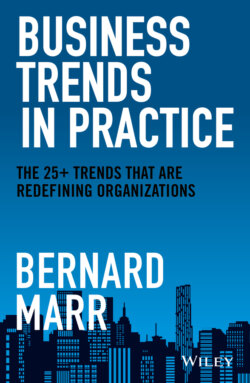Читать книгу Business Trends in Practice - Бернард Марр, Bernard Marr - Страница 29
Trend 8: Gene Editing and Synthetic Biology
ОглавлениеAs Steve Jobs once said, “The biggest innovations in the 21st century will be at the intersection of biology and technology.” It looks like his prediction may be coming true.
We only understand around 2 percent of our genes at present, but even with this small amount, scientists have been able to achieve incredible things – not least the ability to alter the DNA encoded within a cell (known as gene editing). As we unlock more of the mysteries of our genes, we'll find new ways to understand and control them. Understandably, gene editing raises ethical issues for some, but it could deliver some drastic leaps forward in the fight against disease. Gene editing can have particular advantages when “bad” genes are detected – genes that could endanger the health of the organism or its descendants. These harmful characteristics can, in theory, be altered.
Given that the human body contains around 37 trillion cells, the microscopic scale involved in gene editing is truly amazing. The cell's nucleus, where most DNA resides, makes up around 10 percent of a typical cell, so the level of accuracy needed to cut something that tiny is almost inconceivable. At present, the CRISPR (pronounced “crisper”) method of gene editing shows the most promise; it's the simplest way of making precise changes to DNA, such as adding some traits and/or removing others, not unlike the “find and replace” function in Microsoft Word. The CRISPR method was controversially used by Chinese scientist He Jiankui to alter the DNA in the embryos of twin girls to prevent them catching HIV.13 Gene editing like this is banned in most countries and the experiment was widely condemned.
But we're not just talking about editing human DNA here. Plant health can be improved with gene editing. By editing plant genomes, their resistance to pests and diseases can be increased, leading to higher yields and less dependence on harmful chemicals. For example, researchers at Penn State University are working on creating genetically enhanced cacao trees that will be resistant to the disease and fungus that destroys up to 30 percent of the worldwide cacao crop before their pods can be harvested.14 Creating disease-resistant crops like this will play a vital role in feeding our planet in future.
As well as editing genes, it is also possible to synthesize an organism's entire genome. As early as 2002, scientists were able to create the polio virus from scratch by synthesizing its genome. This brings us on to the topic of synthetic biology – or the field of science that's devoted to redesigning organisms. Synthetic biology is similar to gene editing (the ability to read and edit genes lies at the heart of synthetic biology), but while gene editing tools can be used to make small changes to DNA, synthetic biology can involve stitching together long strands of DNA and inserting them into an organism. As a result, the organism may behave differently, have new abilities, or be able to produce a specific substance (such as a fuel).
Harnessing microorganisms is an exciting area of synthetic biology. Life depends on tiny organisms that we can't see, and the idea is that harnessing these microorganisms could help us solve our biggest challenges. Newlight Technologies, for example, has been able to harness microbes to produce a carbon-negative, ocean-degradable thermoplastic that could replace traditional plastic.15 Elsewhere, researchers in Israel have created a bacteria that can live on carbon dioxide directly from the air.16 Some fragrances are already made using synthetic biology, as are cruelty-free leatherlike products and cultured meat, to name just a few examples.
But what does all this mean for businesses? Synthetic biology and gene editing may transform the way we produce products, feed the planet, treat illness, and solve some of the biggest crises facing humanity. Editing tools like CRISPR will help fuel advances in gene editing and synthetic biology, but so too will technologies like AI, which is ideally suited to crunching through vast quantities of data and identifying the right DNA configurations. (This is partly why the human genome can now be sequenced in a week, at a cost of $600, compared to the 13 years and $3 billion it originally took.)17 As such, synthetic biology and gene editing may disrupt some of the world's largest industries, including agriculture, chemicals, and healthcare.
